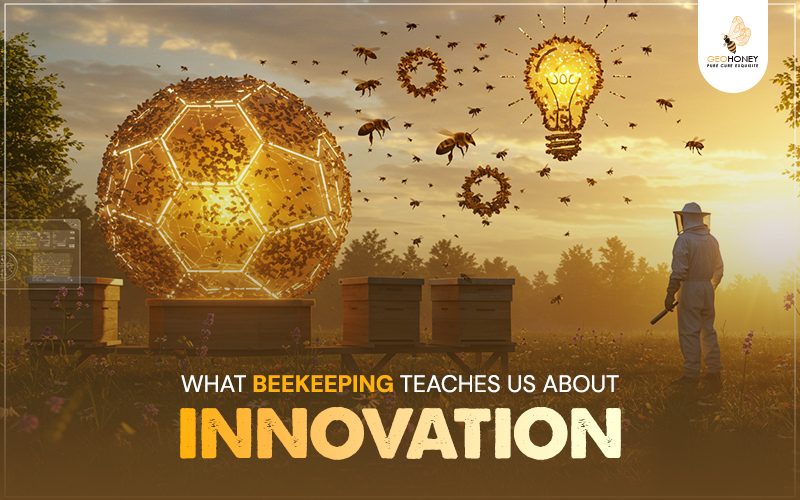- Tokyo: 11:29
- Singapore: 10:29
- Dubai: 06:29
- London: 02:29
- New York: 21:29
What Beekeeping Teaches Us About Innovation

Beekeeping is an ancient practice that humans developed to nurture honeybees and to gather the sweet golden nectar called honey. Just like most things, beekeeping has also evolved and become a commercial sector in the past few centuries.
But apart from extracting honey, what else can we glean from these fascinating creatures and the art of beekeeping? One obvious answer is innovation. Bees are masters of resilience, productivity, and collaboration, all of which are essential for innovation in any field.
“Looking closely at a beehive, there is so much one can learn about the principles of modern evolution.”, says the founder of Geohoney and the CEO of B A Barry Group, Mr Basem Barry.
The quietly productive and collaborative communities of bees can guide anyone who is looking to innovate with purpose and resilience in any arena. This blog sheds some light on how bees can teach us to be more creative and innovative. So, without any further ado, let’s take a closer look at this.
There Is No Innovation Without Collaboration
Experimentation and Failures Are a Must for Innovation
Repetition Equals Efficiency and Elegance
Every Innovation Must Be Rooted in a Purpose
Right Timing Matters
Innovation Without Sustainability is Futile
Resilience and Redundancy Build Lasting Results
There Is No Innovation Without Collaboration
The whole colony of bees is like a superorganism where every organ works in coordination with the rest of the body to produce organic honey. The hive could never grow if foragers, drones, worker bees, and queens did not work in unison.
It is easier to come up with an innovative approach when different interconnected minds are working together towards a single goal. The success of startups and large corporations relies heavily on shared knowledge and collaboration. This is an extremely valuable lesson that one learns when looking at a beehive closely.
Experimentation and Failures Are a Must for Innovation
Bees do not panic or collapse in the face of failure. The swarming bees may fail to find a suitable location, hives may collapse, or queens may prove ineffective. When faced with an unexpected situation, bees learn, adapt, and adjust.
Similarly, beekeepers know that if a hive doesn’t work or if the raw honey yield is low, they need to either change the hive’s type, use different management styles, or experiment with different bees to find a solution that works.
In the same manner, to come up with effective innovations, you need to be willing to experiment and to fail. Just make sure to learn from these experiences to come up with better ideas.
Repetition Equals Efficiency and Elegance
Bees have mastered the art of hive making through repetition over the course of thousands of years. A beehive is a true architectural marvel that has a stable geometry, brilliant functionality, and structural integrity. Bees used iteration to create this innovative ecosystem, which is another key part of innovation.
Your innovative strategy or system should be open to revision and optimization. You have to be open to testing different ideas and repeating and refining your approach to come up with an innovative solution that has some real value.
Every Innovation Must Be Rooted in a Purpose
Every innovation that doesn’t serve a purpose is nothing but noise that will eventually fade away. Honey Bees use innovative dances for communication, select queens based on a system, and build combs using special processes. Every innovative action of the bee has a purpose, which gives it meaning and real value.
Similarly, you need to make sure the innovation you are suggesting is not simply a novelty for novelty’s sake. You need to ask whether this innovation really fulfils the needs of the people and makes life better for them. Purpose-driven innovations are always more marketable, sustainable, and impactful.
Right Timing Matters
Bees have mastered the art of time management. They follow a very strict schedule when it comes to foraging, swarming, honey conserving, etc. They know that snoozing or not capitalizing on the right opportunities will only cost them in the long run.
Successful beekeeping experts are also attuned to these habits of bees as well as external factors like weather patterns, plant cycles, and hive life stages. This is what helps them plan ahead to get the highest yields.
This same approach should be applied in every innovative strategy or system. You need to learn when to act fast and when to take a step back and wait for the right time to make sure your innovation yields the results that you want.
Innovation Without Sustainability is Futile
Every innovative strategy must have sustainability at its center. Bees do not overconsume or deplete their surroundings. They recycle resources to sustain their ecosystems and the planet in general.
We also need to take a leaf out of their book when creating solutions. Our innovative strategies should not focus on extraction but regeneration of resources to make sure both the planet and the people can thrive.
Resilience and Redundancy Build Lasting Results
In the face of a disaster like a queen’s death or some other external threat, bees do not dwell on mistakes or collapse. They reorganize instantly and take the necessary measures to keep the hive going.
They will rear newer queens by changing the way they feed or nurture the younger generation. They also get rid of members or even queens that no longer serve any purpose in their hives.
This is another important lesson in innovation. Every innovative system that is built to last longer must be resilient and future-ready. It is always a good idea to have a backup and emergency plan in place instead of relying solely on a single strategy.
Conclusion
There is no innovation without cooperation, adaptivity, resilience, and creativity, and when you look closely at a beehive, you notice all of these elements in play. Bees do not resist change; instead, they embrace it with intelligence and adapt to their surroundings, which is what every innovator that has ever existed has done.
No matter what your industry is, you can always look at a beehive and learn fascinating lessons about creativity, innovation, and leadership.
You don’t have to look far to understand the basic principles of innovation, just observe these busy creatures at work or chat with someone who has done beekeeping for years to know all you need on the subject.
You can visit us at Geohoney if you are looking to buy premium quality, raw honey at very reasonable rates, and to learn more about bees and beekeeping.



